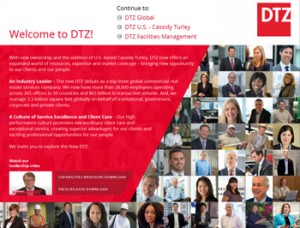30th January 2015
Commercial property investors can be bold in 2015
This week I attended DTZ’s 2015 Outlook seminar which looked at commercial property investment in the UK and across the globe. The presentation revealed that UK commercial property investment reached an all-time high in 2014, with £54.9 billion transacted, with the increase driven by investment outside of London, which increased from £25.4bn in 2013 to £34.4bn in 2014.
The big question at the event was whether 2014 was a year to be bold for investors and the general consensus was ‘yes’. More importantly, it also asked “Should investors put money into commercial property in 2015?”. Again, the answer was that commercial property investors can be bold in 2015.
Investors will have to look to the secondary sector
The comprehensive research from DTZ found that £28bn of cash is currently looking for a home in commercial property investment, including the institutional funds I’ve mentioned in earlier blogs.
 However, Ben Clarke, Head of UK Research at DTZ, also said that prime property yields will stagnate in 2015 across the regions and have already stabilised in London. What that means is that growth will have to come from the secondary sector.
However, Ben Clarke, Head of UK Research at DTZ, also said that prime property yields will stagnate in 2015 across the regions and have already stabilised in London. What that means is that growth will have to come from the secondary sector.
For example, investors will now have to consider investment properties where quality tenants have short leases that will have to be renegotiated in the next few years. However, rental growth and burgeoning occupier confidence means that investors can also be more confident.
These key factors ensure that landlords no longer have to offer soft deals to keep their tenants. Even if you are unable to renegotiate a deal, occupier demand is such that finding a new tenant is less of a challenge in this improved market. Plus, the DTZ research shows incentives like rent free periods have also been slashed by one third.
The regions remain attractive for commercial property investors
 Unsurprisingly, the research showed that the regions would continue to be hugely popular with investors. Increasing demand and limited supplies means the regions continue to offer higher yields than London.
Unsurprisingly, the research showed that the regions would continue to be hugely popular with investors. Increasing demand and limited supplies means the regions continue to offer higher yields than London.
Domestic retail funds dramatically increased their interest in the regions during 2014 and, while overseas investment continued to dominate London, representing 68% of transactions, the big increase in foreign cash was in the regions. The overseas share of the market increased from 28% in 2013 to 36% in 2014, driven primarily by investment from the US, China and Europe.
What this means is increased competition and, as a result, prices in the region will become keener while yields are compressed.
What are the risks for commercial property investors?
At the event we heard that total property returns in 2014 were 20%. While that figure won’t be as high in 2015, it will still be double-digit returns.
On the face of it, it’s all good news but there are a few isolated risks to consider. The ultra-low interest rate environment coupled with the weight of money in the market and the lack of stock could over-inflate prices and that could be counter-productive to the market.
The question is whether rental growth will catch up in time for when the money is spent? Growth will not be as fast as in 2014, but I believe we’ll continue to see a gradual increase going forward and that will be ideal for the market. Ultimately, the opportunities continue to outweigh the risks.
Interestingly, the research found that bank exposure to commercial property is down 35%. While this figure may raise a few eyebrows, it is misleading. The banks are still lending and are more aggressive, but there is still a lot of cash out there and that is being spent first – which is sensible.
What does this mean for syndicated commercial property investors?
From our perspective, what this means is that we will have to work harder to find quality assets for our syndicated property investors.
 The good news is that investors can take more confidence in secondary rental growth and that makes the secondary market more attractive and worth the increased risk, a view shared at the presentation by Greg Davison, Investment Director at DTZ in Leeds. Put simply, if existing tenants don’t renew there will be others ready to sign up.
The good news is that investors can take more confidence in secondary rental growth and that makes the secondary market more attractive and worth the increased risk, a view shared at the presentation by Greg Davison, Investment Director at DTZ in Leeds. Put simply, if existing tenants don’t renew there will be others ready to sign up.
We will still be able to deliver double-digit returns in 2015 and we will still see solid capital growth as the market continues to grow.
One example of this is the Whisky Maturation Warehouse our clients purchased a year ago. Investors in that syndicate have enjoyed 8.75% per annum return and the latest valuation has shown that the warehouse has increased in value by 8-10% over the past 12 months.
If you have any further thoughts on what lies ahead for 2015, please share them in the comments below.
